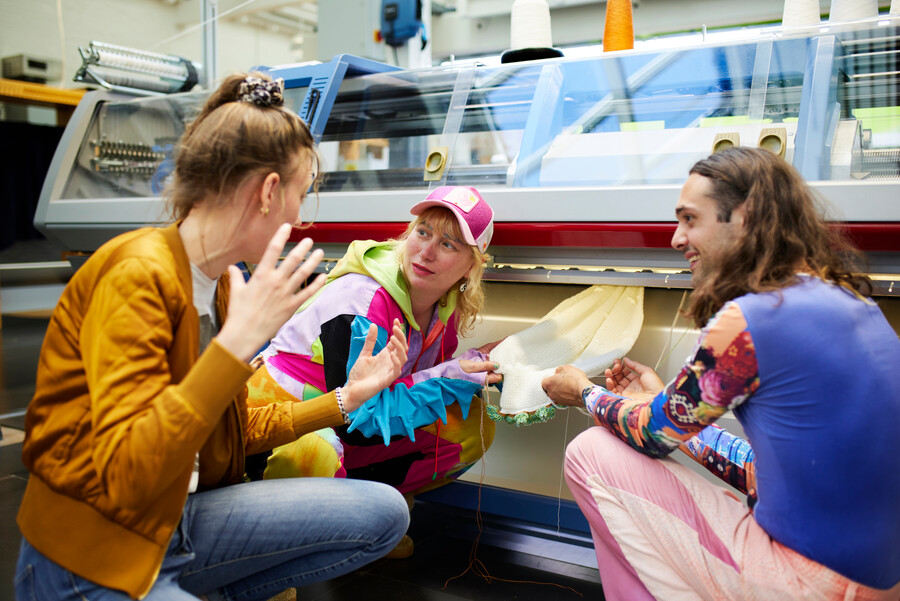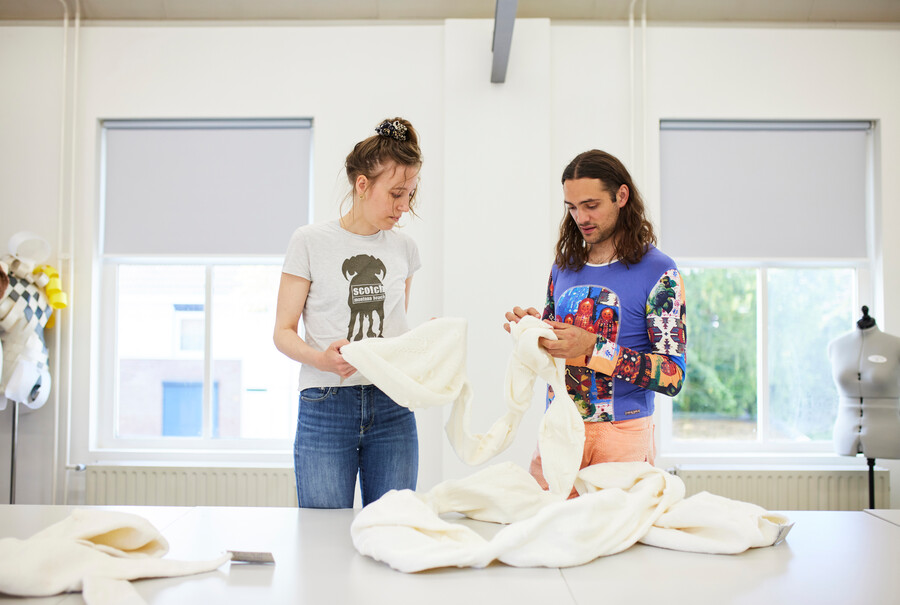For the TextielMuseum’s collection, melanie bonajo and Théo Demans designed a colourful cushion landscape you can sink into. The fact that neither of the makers had any knitting experience was not an issue. Product developer Sarena Huizinga translated their sketches into a series of whimsical 3D knits that spark the imagination.
Textiles’ increasingly prominent position in the visual arts is at the heart of this summer’s exhibition Textile now – each thread tells a story . The museum’s commission programme is contributing to this development by introducing talented artists to the textile medium. Textile now will display, among other things, the results of five collection commissions. With support from the Mondriaan Fund, these grew into special works in the TextielLab. Made using innovative techniques, the works respond to topical themes such as identity, diversity, sexuality, gender, decolonisation and the environment. “In a few months, this exhibition will present the crème de la crème of everything the lab has to offer,” says head of the lab Hebe Verstappen. “We put a lot of resources into this programme to help makers grow.”
Travelling through a flower
One of those makers is artist melanie bonajo, who developed the concept for a sensual cushion landscape that explores intimacy and touch. “Imagine being able to travel through a flower,” says bonajo. “I wanted to create a sexualised, sweet, colourful and safe space.” In close cooperation with bonajo and product developer Sarena Huizinga, product designer Théo Demans got to work in the TextielLab. Previously, bonajo had made their installations from existing textiles. Developing shapes on the knitting machine, which the lab team recommended when bonajo presented their ideas, was a new step. “It’s no problem for us if you’ve never knitted anything before,” says Huizinga. “If you have a clear vision, I can translate it into a knitting project for you. The advantage of knitting over weaving is that you are not limited to a straight piece of fabric. You can knit the shape you want right on the machine.”

Sarena Huizinga, melanie bonajo and Théo Demans at the flat knitting machine. Photo Tommy de Lange
“It’s no problem if you’ve never knitted anything before”
Sketches
Twelve woollen cushion covers in various shapes were developed on the flat knitting machine. Says Huizinga, “When melanie and Théo came to me with drawings and sketches, we first looked at which shapes were a good match for the machine. The initial drawings, in which everything was made from a single piece of fabric, were a bit too complex for the time available. We ultimately selected four basic shapes: a ball chain, a doughnut, a potato shape and a kind of molar with roots. We then made all sorts of variations of them. These shapes, including all the spots and nipples, came off the machine fully formed. No finishing was needed, other than filling and colouring by the artists themselves.”
Shrinking and felting
The team experimented extensively with materials and techniques before the final choices could be made. Knitting the different 3D shapes was just the start. In addition, the knit had to have the right density so it could be firmly filled and retain its shape. Tactility was also important: softness is a must for ‘cuddly cushions’ like these. The loose knit was washed with soap at 40 degrees. This caused it to shrink and felt at the same time, closing the ‘open’ structure and creating a firm but soft layer. As it happened, Huizinga was already making cushion covers with this technique and was able to use the knowledge she had acquired for this project. Because some materials shrink more than others, it took time to find wool with the right properties. Mohair, for example, became a tangled mass in the washing machine. After numerous tests, the team settled on 100% Merino wool, which produced the desired shapes and protrusions on the knitting machine and felted well.

Sarena Huizinga and Théo Demans inspecting the tests. Photo Tommy de Lange
Workshops
As there are limitations to knitting colour patterns in 3D shapes, the team decided to make the cushion covers from white Merino. Using different spraying and painting techniques, bonajo and Démans then added their own colourful signature to this ‘blank canvas’. The result, poetically titled ‘Piles of Oxytocin Shapes Dreams Under Skin’, will be shown to the public for the first time in June. Comprising 12 brightly coloured, metre-long cushions that resemble exotic plants or reproductive organs, this is not just art to be admired from a distance. This is a pillowy paradise you can sink into while listening to interviews about intimacy. Those interested in exploring intimacy themselves can sign up for one of the workshops bonajo will be giving during the exhibition. “My aim is to help you discover where your needs and boundaries lie when it comes to physical touch and how you can best communicate them,” says bonajo. “Together we will explore how a yes and a no feels in your body.”